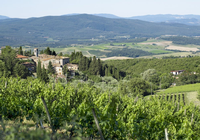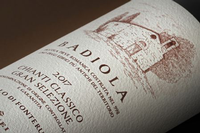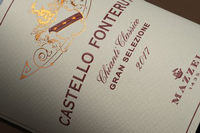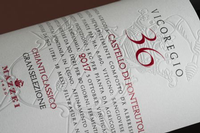With the release of a trio of 2017 Gran Selezione wines, Castello di Fonterutoli is leading the way, showing the importance of terroir—site specificity—in Chianti Classico. Chianti Classico producers have long proclaimed that there are major differences among the wines produced in the region’s nine subzones. And it’s true that a Chianti Classico from Radda tastes different from a Chianti Classico from neighboring Castellina in Chianti. But heretofore it’s been almost impossible to know  whether the differences were really due to the subzone or to the producer’s style. After all, when you taste a Chianti Classico made by Cecchi, whose base is in Castellina in Chianti, side-by-side with one made by Castello di Radda, whose vineyards lie in the Radda subzone, are you tasting the difference between producers or subzones?
whether the differences were really due to the subzone or to the producer’s style. After all, when you taste a Chianti Classico made by Cecchi, whose base is in Castellina in Chianti, side-by-side with one made by Castello di Radda, whose vineyards lie in the Radda subzone, are you tasting the difference between producers or subzones?
Castello di Fonterutoli has eliminated that dilemma. Though situated in the south eastern corner of Castellina in Chianti, Castello di Fonterutoli has vineyards in Radda and Castelnuovo Berardenga in addition to their home base. They produced three wines in 2017, each of which comes from one of those subzones: Badiòla, a single-vineyard wine from Radda; Vicoregio 36, a single-vineyard bottling from Castelnuovo Berardenga; and Castello Fonterutoli, their flagship, a multi-vineyard blend, from Castellina in Chianti. Thanks to Zoom® and their importer, Taub Family Selections, Giovanni Mazzei, Fonterutoli’s export manager, commented on the wines as a group of us tasted them side-by-side.
Before getting to the wines, here’s a little background. Chianti Classico is the heart and most important subregion of the greater Chianti area, which extends from Florence to Siena in Tuscany. “Gran Selezione” is a recently created category that sits at the pinnacle of the Chianti Classico quality pyramid, above Riserva. It represents about six percent of Chianti Classico’s total production. To put that into perspective, Burgundy’s Grand and Premier Cru wines account for 11 percent of that region’s production. No stranger to Chianti Classico, the Mazzei family has owned Castello di Fonterutoli since 1435, which means that Giovanni represents the 25th generation.
Castello di Fonterutoli, Chianti Classico Gran Selezione, “Badiòla” 2017 ($99, 93 pts):  Mazzei believes that the vineyard’s southern exposure and high elevation (almost 1900 feet above sea level) combines great sunlight with large diurnal temperature variation, the combination of which results in ripeness and freshness. This finesse-filled wine delivers bright fresh red cherry-like notes mingled with mineral nuances. It has the racy energy of Chianti Classico combined with great elegance supported by suave tannins. Mazzei calls it a “vertical” wine.
Mazzei believes that the vineyard’s southern exposure and high elevation (almost 1900 feet above sea level) combines great sunlight with large diurnal temperature variation, the combination of which results in ripeness and freshness. This finesse-filled wine delivers bright fresh red cherry-like notes mingled with mineral nuances. It has the racy energy of Chianti Classico combined with great elegance supported by suave tannins. Mazzei calls it a “vertical” wine.
Castello di Fonterutoli, Chianti Classico Gran Selezione “Castello Fonterutoli” 2017 ($74, 94 pts): The grapes for Castello, as Mazzei calls it, come from 11 different plots around the hamlet of Fonterutoli. Each plot is vinified separately, allowing precision in constructing the blend. The 2017  is the first year the wine was made entirely from Sangiovese. In the past, they included small amounts of Colorino and Malvasia Nera, but Mazzei noted that after 25 years of research with Sangiovese, they finally decided that was the way forward. It’s slightly higher alcohol, 13.8% compared to 13.57% for the Badiòla, reflects just a touch more ripeness. Indeed, the flavor profile tends toward darker cherry notes in this slightly weightier wine. Suave tannins, a hallmark of all of wines from Castello di Fonterutoli, lend support. It’s another racy and elegant wine.
is the first year the wine was made entirely from Sangiovese. In the past, they included small amounts of Colorino and Malvasia Nera, but Mazzei noted that after 25 years of research with Sangiovese, they finally decided that was the way forward. It’s slightly higher alcohol, 13.8% compared to 13.57% for the Badiòla, reflects just a touch more ripeness. Indeed, the flavor profile tends toward darker cherry notes in this slightly weightier wine. Suave tannins, a hallmark of all of wines from Castello di Fonterutoli, lend support. It’s another racy and elegant wine.
Castello di Fonterutoli, Chianti Classico Gran Selezione “Vicoregio 36” 2017 ($99, 93 pts):  The Mazzei family planted 36 biotypes of Sangiovese in their Vicoregio vineyard in Castelnuovo Berardenga. Hence the name of the wine. This one, the deepest of the trio, conveys black cherry-like flavors, bordering on plumy ones, reflecting the warmth of Castelnuovo Berardenga. Still, it retains incredible freshness and vibrancy. Mazzei characterizes it as a “wider” wine compared to the “vertical” Badiòla.
The Mazzei family planted 36 biotypes of Sangiovese in their Vicoregio vineyard in Castelnuovo Berardenga. Hence the name of the wine. This one, the deepest of the trio, conveys black cherry-like flavors, bordering on plumy ones, reflecting the warmth of Castelnuovo Berardenga. Still, it retains incredible freshness and vibrancy. Mazzei characterizes it as a “wider” wine compared to the “vertical” Badiòla.
Though the winemaking is not identical for the three wines, with oak aging varying slightly, and the age of the vines differing in the three subzones, the wines are all made entirely from Sangiovese and at the same winery. Most critically, the winemaking philosophy is the same. So, the differences among the wines reflect their respective subzones of Chianti Classico.
The wines can be purchased as a set of three. This allows consumers to hold a tasting with a small group of friends, complying, of course, with local regulations regarding size of gatherings, to see for themselves how the wines from Chianti Classico, similar to Burgundy or Barolo, differ according to where the grapes grow.
